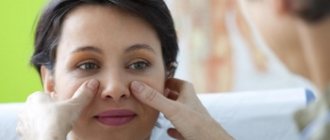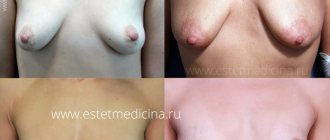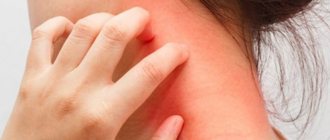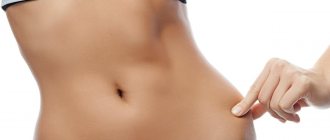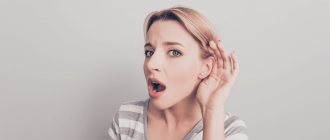A sloping nape in a child is a very worrying topic for parents because... Visually, this shape of a newborn’s head looks unpleasant, and many people think that the brain may be shrinking, etc. mom's fears. In fact, children are clearly not bothered by this head shape, but there is another, bad feature: with a sloping head, the child lies on his back with the flattened part of his head against the mattress, and it is very difficult for him to turn his head in such a situation. Due to the predominantly turned head when the child is lying on his back, firstly, the flattening of the back of the head becomes even stronger, and secondly, the muscles, ligaments, and joints of the neck get used to turning the head in one direction, and turning it in the other becomes even more difficult, because the musculoskeletal system is used to it. Often, the sloping back of the head in an infant and the habitual turn of the head develop in parallel, and are mutually reinforcing factors.
The reason for the formation of a sloping nape in a baby
1. The main reason, of course, is the head lying for a long time with a turn in one direction. In newborn children, the bones contain a lot of cartilage, and therefore they are soft and not very, but still easily deformed under the prolonged influence of gravity of the body itself or other mechanical influence. The key word here is “long-term”; it is because of prolonged pressure on the bones of the skull that deformation of the back of the head occurs in infants, and of course, the age-related characteristics of the “softness” of the children’s skeleton play a role. 2. There is also a reason for the head to constantly lie turned only in one direction. More often, this position of the head is ensured by the motor apparatus of the neck and head, which in newborns very often works asymmetrically due to injuries during childbirth, such as torticollis.
Seams that allow movement
The newborn's skull consists of five main bones: a pair of frontal bones, a pair of parietal bones and one occipital bone. These bones are connected by fibrous sutures that allow the bones to move relative to each other, facilitating birth and brain growth.
Normally, the coronal suture separates the two frontal bones from the parietal bones. The metopic suture separates the frontal bones. The sagittal suture separates the two parietal bones. The lambdoid suture separates the occipital bone from the two parietal bones.
But sometimes something goes wrong... Genetic mutations, which can be local in one area or have a systemic, widespread nature, lead to the sutures closing prematurely.
If the closure of one or another suture is accompanied by other anomalies, such craniostenosis is called “syndromic”. Syndromes characterized by premature closure of cranial sutures: Crouzon Syndrome, Apert Syndrome, Pfeiffer Syndrome, Satpre-Hotzen Syndrome, Carpenter Syndrome and others.
Craniostenosis can be a component of various hereditary syndromes. But in most cases, the hereditary nature of the disease is not confirmed, and craniostenosis does not appear in subsequent generations.
An unusually strong degree of craniostenosis (type scaphocephaly) was present in the so-called “Stettian weaver” (Bonnet, 1904). It was a worker from one of the weaving factories in Stettin. His skull was so long and narrow that the back of his head rested against his back when the unfortunate man tried to raise his head. It was said about the “Stettin weaver” that he never saw the sky and always looked gloomily at the ground. Persecuted for his ugliness by ridicule, he died of pleurisy in the 38th year of his sad life...
Sometimes not one, but several seams are subject to early overgrowth. This also leads to deformation of the skull.
In cases where sutures such as the coronal and sagittal close prematurely, the small dimensions of the upper part of the child’s skull seem to be fixed and their increase stops. Since the growth of bones in the preserved sutures of the skull continues, the so-called “tower” head appears in the adult. The skull becomes elongated upward and slightly backward.
What else should you pay attention to?
Deformation of the back of the head can be not only oblique (this is only when the head is turned), but also in the frontal plane. This is possible with rickets, or the inability to turn the head. Tight cocoons, cribs, cradles are not the best place for a child. Try sleeping all night in one position yourself. Increased attention to the case of rickets, because in this case, deformations form faster. The most dangerous period for the formation of a sloping nape is up to 3 months of age. Children older than three months usually lie on their stomach or side more often, move more, roll from side to side, having learned to roll over from back to stomach, they regulate their position, i.e. the head does not lie in one place for a long time.
Signs of the disease
The atypical shape of the skull is flattened in the occipital region. Rarely – elongated in the frontal direction or compressed from the sides. Characteristic frontal or temporal bulges and protrusions of the parietal region are possible.
If head asymmetry is caused by congenital anomalies, then without treatment the pathology progresses. Over time, it can cause negative consequences in the child - increased intracranial pressure and the symptoms caused by it. Source: E.V. Mamedov Plagiocephaly. II. Synostosis, deformation and compensatory // Pediatric surgery, 2003, No. 5, pp. 45-50
How to correct a sloping nape in a child?
In newborns aged 1-2 months, it is important to monitor the position of the head, especially if the child begins to like to look in one direction. At such an early age, children do not have much strength to turn their heads often, so you can help them. 1. Having noticed such a picture in your baby, do an exercise in the form of fixing the child’s head by turning it in the opposite direction than usual, and holding it for several minutes, several times a day. This exercise is to get the muscles and ligaments of the neck used to working in the other direction. With such fixation for several minutes, the obliquity of the back of the head is not corrected quickly, but it must be done so that the child can then turn his head normally on his own. 2. One of the auxiliary options is a children's orthopedic pillow with a notch in the middle. The pillow helps the child keep his head straighter. This method can be used during daytime sleep. But control is needed, because the child may spit up. 3. The most important and reliable way to correct a child’s sloping head is his physical development. If the child moves a lot, lies on his stomach, sits, crawls, stands on his feet, then under the influence of gravity the sloping head will straighten itself. The brain, with the head in a vertical position, will exert pressure on the walls of the skull from the inside, thereby leveling (squeezing out) and rounding the flattened bones of the skull. This does not happen very quickly, but it is the only way to realign the bone from inside the skull.
The importance of head shape and possible complications
Osteopathy attaches great importance to the shape of the skull, since it is the correct arrangement of the bones and its components that determines the balance of the membranous membranes of the brain and the possibility of its micropulsations. Due to the distortion of the geometry of the head, disturbances in the blood supply to the brain can be observed, which negatively affects not only the brain itself, causing the death of nerve cells, atrophy of part of the cortex, but also the organs for which this part of the brain is responsible for their work and interaction.
Possible complications arising from disturbances in the geometry of the cranium:
- Frequent otitis media, which are difficult to treat and often have relapses;
- Impaired hearing, vision, smell, taste. They can manifest themselves to varying degrees and be combined with each other;
- Frequent colds, runny nose, allergic reactions to flowering;
- Problems with appetite, abdominal pain, indigestion and stool disorders;
- Development of malocclusion, dental problems;
- Irritability, nervousness, poor sleep;
- Mental development disorders. School-age children may also develop absent-mindedness syndrome, learning delays, minimal brain dysfunction, etc.
The aesthetic component is also important. Violation of the geometry of the cranium, asymmetry is reflected in the child’s face. This is not only unsightly in itself, but can also cause psychological trauma as you grow older.
Timely help from an osteopath allows you to eliminate the disturbances, restoring the normal geometry of the cranium, which also allows you to restore the lost equilibrium position of the meninges and normalize blood circulation. Broken nerve connections are restored or replaced with new ones, which leads to the elimination of brain dysfunctions and prevents possible problems with other organs and parts of the body.
Will massage help a baby with a sloping head?
Sometimes people ask me, if a baby has a sloping head, what should they do, what kind of massage would you recommend. But massage does not play the first role in the treatment of a sloping nape in an infant, and this problem cannot be corrected by massage itself. Massage will not be able to bend the bone, even though it is soft. With the help of massage, we make the child more mobile, and mobility is already the most important healing factor for this problem. It is the prolonged lying of a child with an unevenly fixed head that most often leads to the formation of a slanted, flattened head. Therefore, massage for a child with a beveled head is aimed specifically at general physical development, in which the baby will not lie in one position for a long time, but will constantly move. In this way, the harmful factor is minimized and the beneficial factor is increased.
Others unwillingly
The first written mentions of skull deformation are found in ancient authors. In the V-IV centuries. BC e. Hippocrates, in his text “On Air, Waters and Places,” described the long-headed people, or macrocephals, living on the eastern shore of the Black Sea. Their elongated heads were a sign of belonging to the elite. However, from the text it becomes clear that macrocephals themselves voluntarily deformed the skulls of their babies.
“They consider those with the longest heads to be the noblest. ... as soon as the child is born, while his bones are still soft, his unhardened head is straightened with his hands and forced to grow in length through bandages and other suitable devices, as a result of which the spherical shape of the head deteriorates and its length increases.”
However, modern parents are often faced with congenital, unintentional deformation of the skull. And, unfortunately, it does not make their children a sign of belonging to the elite, rather the opposite...
The word "craniostenosis" comes from the Greek. cranio – “skull” and stenosis – “fusion of bones”. As recognized by the Association of Neurosurgeons of Russia, craniosynostosis (or craniostenosis) is “a disease manifested by the congenital absence or premature closure of the sutures of the skull. Premature synostosis in the area of the sutures of the skull leads to limited growth of the skull in the area of the closed suture, resulting in the development of craniocerebral disproportion. The clinical manifestation of craniocerebral disproportion is intracranial hypertension syndrome.”
Prevention of the formation of a sloping head in children.
While the child is small, 1-2 months old, it is advisable for him to do at least a little gymnastics, and regularly. Rolls from back to stomach, turns to the side, movements of the limbs, turns of the head to the right and left up to 90 degrees (so that the cheek lies parallel to the surface on which the child is lying). The baby needs to change his position in the crib, i.e. turn it with your head, one day it lies in one direction, the next day in the other. This is so that the baby, when he pays attention to sounds, people, lights, turns his head towards them, every day in a different direction. Also, lying on your side and stomach is very useful; with such poses, a sloping neck does not occur.
Earfold implants
The latest solution at the intersection of surgery and conservative treatment methods. This is a minimally invasive alternative to surgery that provides good cosmetic results. The patented technique allows you to remove protruding ears, provided that the implants are constantly worn. Elimination of protruding ears is based on the fact that special mini-implants several millimeters in size are implanted into the ears. With their help, the cartilage is gradually rebuilt, the shape of the ear changes, and a correction effect is achieved. EarFolds are biocompatible, so there is no need to get rid of them in the future.
How are implants designed?
Each implant is a thin curved metal plate made of an alloy based on nickel and titanium, coated with medical gold. Thanks to this composition, biological compatibility is achieved, which is important because products for correcting protrusion must be located under the skin.
How to get rid of protruding ears using earfold?
The implantation procedure is carried out under local anesthesia and takes 20-30 minutes. Before it, precise positioning is carried out on an individual basis. Through an incision of about 1 cm, the implant is inserted under the skin and takes the desired shape, fixing the cartilage in the correct position. After this, two stitches are applied. The product holds the ear in the desired position.
So far, this technique is not very widespread, and the products themselves are expensive.
How to get rid of protruding ears through surgery?
Surgical correction is the only completely effective way to get rid of a defect with a guaranteed result. The operation is called “otoplasty” and is performed from 6-7 years of age, including adults.
There are two methods of otoplasty – classic scalpel and laser. An incision about 4-5 cm long is made at the back of the ear. Through it, the cartilage is released, which is then trimmed and attached in a new place. When using a laser, manipulations are more precise and almost bloodless. After the operation, stitches, a bandage and an elastic bandage are applied. The procedure lasts about an hour under general anesthesia or local anesthesia.
Read more about otoplasty here
